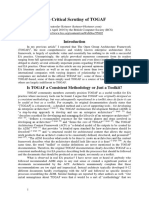Chapter Two 2.balconies, Loggias, Canopy and Terraces: Dire Dawa Poly Technical College Satellite Program
Chapter Two 2.balconies, Loggias, Canopy and Terraces: Dire Dawa Poly Technical College Satellite Program
Uploaded by
Temesgen YohannesCopyright:
Available Formats
Chapter Two 2.balconies, Loggias, Canopy and Terraces: Dire Dawa Poly Technical College Satellite Program
Chapter Two 2.balconies, Loggias, Canopy and Terraces: Dire Dawa Poly Technical College Satellite Program
Uploaded by
Temesgen YohannesOriginal Description:
Original Title
Copyright
Available Formats
Share this document
Did you find this document useful?
Is this content inappropriate?
Copyright:
Available Formats
Chapter Two 2.balconies, Loggias, Canopy and Terraces: Dire Dawa Poly Technical College Satellite Program
Chapter Two 2.balconies, Loggias, Canopy and Terraces: Dire Dawa Poly Technical College Satellite Program
Uploaded by
Temesgen YohannesCopyright:
Available Formats
DIRE DAWA POLY TECHNICAL COLLEGE SATELLITE PROGRAM
CHAPTER TWO
2.Balconies, Loggias, Canopy and Terraces
2.1 Introduction
In conventional design, joints at the roof connection must be neatly formed, possibly with shade
strip in lays. Elements should have anchor reinforcement for strong floor connection. All
horizontal and vertical traverses must be well executed. The slope of the breast surface should
be directed inwards and the top side neatly' smoothed so that water does not flow outwards.
Around the balcony slab, the breast should be recessed so that the cover surface can be applied
approx. 6 - 12 cm on the interior wall. In order for the water to drip off the element directly, the
underside must slope toward the outside. With normal types of concrete on concrete, a de-
watering nib must be mounted parallel to the outer line. (The inlay strip is to be removed
immediately after dismantling.) Rain or wash water falling on the floor of the balcony is drained
outwards at the lowest point in the slope by spouts or by a direct connection to the roof drainage
system. (If possible, it should not be routed into the sewage drain; however, if there is no other
possibility, a conduit siphon must be installed)
The inner sides of flower troughs are to be neatly smoothed. One or two coats of asphalt are
necessary. Trough drainage or overflow is provided by a sieve. The 8 - 15 cm-deep seepage bed
and humus may be inserted approximately, ten days after coating, otherwise plants will die
prematurely. If the flower troughs are not accessible, a pipe sprinkling system should be installed
over the entire length. Brackets. Support attachments. Etc. are best secured with patent
1. Balcony: A plat form projecting from a wall, enchased by a railing or balustrade,
supported on brackets or columns or cantilevered out. In other words, it is an
open air plat form freely projecting from a building.
2. Loggia: A gallery open on one or more sides, sometimes pillared: it may also be
a separate structure, usually in a garden, it is the reverse bay or a balcony built in
to the room.
BUILDING CONSTRUCTION ll INSTRUCTOR GULEMA ASEMERA (M.SC.)
DIRE DAWA POLY TECHNICAL COLLEGE SATELLITE PROGRAM
3. Canopy: A projection or hood over a door, window, tomb, alter, pulpit, niche,
etc.
4. Terrace: A level promenade in front of a building and Arrow of attached houses
designed as a unit.
5. Bay. A vertical division of the exterior or interior of a building marked not by
walls but by fenestration, an order, buttresses, units of vaulting, roof
compartments, etc.
6. Veranda: An open gallery or balcony with a roof supported by light material
usually metal supports
7. Porch: the covered entrance to a building; called a portico, if columned and
pediment like a temple front.
2.2.1 Balconies
“Balcony” is also a term that comes from Latin. “Balcone” defined a large window. These
days, a balcony is an elevated platform which extends from the walls of a building. It can
be attached to any of the room of a house and it can also connect two or more spaces.
Balcony is a structural floor which makes it different from veranda supported from below
rather than in cantilevered form. The usual application of balconies on upper floors of
more than one story buildings. They serve as a link between the interior spaces and the
surroundings. But even so, even a tiny balcony can make a room feel a lot larger, more
airy and open.
BUILDING CONSTRUCTION ll INSTRUCTOR GULEMA ASEMERA (M.SC.)
DIRE DAWA POLY TECHNICAL COLLEGE SATELLITE PROGRAM
2.2.2 Function of Balcony
Balconies are often used as extensions for the indoor living space. The wall separating the
two areas can be removed but this means the balcony would have to be enclosed. A lot
of people keep potted plants in the balcony, transforming it into a small garden, a lovely
addition to an apartment. But if the balcony is connected to the kitchen for example,
BUILDING CONSTRUCTION ll INSTRUCTOR GULEMA ASEMERA (M.SC.)
DIRE DAWA POLY TECHNICAL COLLEGE SATELLITE PROGRAM
then it can also be used for storage or for keeping large appliances like the washing
machine and dishwasher
2.2.3 Types of Balcony Structure
1. Balcony forming part of the structural floor. This is an extension of structural
floor now a day. It is the most common type of balcony construction employed in
building balconies together with the integral floor.
2. Balcony fixed to structural floor. In this type of balcony, the structure of the unit
is securely fixed to the floor joists. This method is applicable in wooden and steel
construction, especially, for later modifications.
3. Balcony insulated from structural floor. In cold climatic areas where insulating
the internal structures from cold external temperature or when later codifications
necessitate use of balconies, the structure of a balcony is constructed
independently from structural floor. Such application is used when the external
wall is quite thick and solid.
4. Hanging Balconies. Such balcony is constructed by securing it to a wall using a
console bracket at the outer part. The bracket is a tie-rod connected to the
balcony which is commonly timber for such construction. The tie rod can be
secured to a wall in diagonal way or as a banister (forming rail and post) these
types of balconies are not used for multi-story buildings as they have problem of
durability.
5. Bottom supported balcony It is a balcony supported from below by securing to a
wall or using a post. It is the simple and also stronger type. It is mostly applicable
in timber constructions.
2.2.4 Materials for Balconies
1. Wood: it is used in wooden buildings. Wooden joists are used as structure of the
balcony. Internal floor joists should not, as a rule, be projected/ extended to
outer side to be a balcony. Thus, balcony structures should be supported by
timber beams secured either directly to the floor joists or transversal cross bars.
BUILDING CONSTRUCTION ll INSTRUCTOR GULEMA ASEMERA (M.SC.)
DIRE DAWA POLY TECHNICAL COLLEGE SATELLITE PROGRAM
Water-penetration / dampness to the balconies can be protected by providing
certain slope to the outer side and a cover of waterproof floor material.
2. Concrete: concrete balconies are used when the integral floor is vein forced
concrete. The balconies can be either on console slab rigidly attached to outer
wall or on a concrete slab as a continuation of the floor slab. The floor finishing
material is usually cement tile, marble tile or chips, terrazzo tile. Water-proofing/
repellent base is provided by using cement mortar or other water proofing
materials. The general slope is to outer side with drop moulding at the end.
3. Steel Balconies. This is an old type of balcony construction which is usually built
with console brackets of cast iron anchored to wall. The current trend is use of
welded beams secured to floor and front wall. The floor is usually wooden
structures or some times concrete slabs. The floor finish is asphalt or terrazzo clay
tile to insulate water penetration
4. Banisters Balcony banisters should strong enough to resist quite big horizontal
stresses which are basically greater than that on common wall. Appearance and
resistance to water should also be properly considered. The construction detail of
balcony banister is same to that of stairs.
2.3 Loggias
Loggia is a design feature of Italian origin referring to a gallery or corridor found on the ground
level (sometimes above), located on the facade of a structure and exposed on one side,
supported by columns or pierced openings in the wall. The floor of a loggia is part of the
integral floor and thus the loggia floors are not projected ones: the common character is that
loggias are provided with side walls except for corner loggias.
BUILDING CONSTRUCTION ll INSTRUCTOR GULEMA ASEMERA (M.SC.)
DIRE DAWA POLY TECHNICAL COLLEGE SATELLITE PROGRAM
Bays
In general, bays are parts of interior spaces/ rooms. The floors of bays are commonly projecting
structures or in other words, roofed and closed –in balconies. Some bays are provided with
supports at the outer ends.
2.4 Terraces
The term “terrace” comes from Latin where it means “earth” indicating the fact that a terrace is
built on a raised plan. So basically this space is a raised flat area, usually at the top of a building
or residence.
BUILDING CONSTRUCTION ll INSTRUCTOR GULEMA ASEMERA (M.SC.)
DIRE DAWA POLY TECHNICAL COLLEGE SATELLITE PROGRAM
Modern-day terraces can serve a variety of purposes. They can be open gardens for example,
an increasingly popular feature in urban areas. Having a beautiful garden in the middle of a
busy city is very refreshing and rejuvenating. On a terrace you can also install a Jacuzzi or even a
pool and turn the space into a beautiful oasis.
Not all the buildings offer direct access to the terrace. The top floor is often an enclosed space
and they usually sell for a lot more because of the flexibility the terrace offers. These spaces are
used for dining, refreshment, speaking plat for (pulpit), outdoor working area, etc.
BUILDING CONSTRUCTION ll INSTRUCTOR GULEMA ASEMERA (M.SC.)
DIRE DAWA POLY TECHNICAL COLLEGE SATELLITE PROGRAM
2.5 Verandah
Verandahs first appeared in colonial buildings during the 1850s. The word actually comes from
the Hindi word varaṇḍā or the Portuguese word varanda.
Verandah or veranda is an open-air gallery or porch, with a roof, attached to the outside of a
building. It usually extends across the front and sides of the structure. Most people also use a
railing for the verandah. In fact, they are similar to a balcony on the ground floor, giving easy
access to outdoors. Moreover, you can use verandahs for all sorts of activities.
BUILDING CONSTRUCTION ll INSTRUCTOR GULEMA ASEMERA (M.SC.)
DIRE DAWA POLY TECHNICAL COLLEGE SATELLITE PROGRAM
Verandah and balcony are two architectural structures present in some houses. While both
verandahs and balconies are spaces with open-air. However, there are some differences there
are four basic styles of verandahs in architecture: curved, flat, gabled and bull nosed / covered.
Homeowners can choose a style they like based on the style of the house, landscape, and size
of the land.
Verandah verses Balcony
Verandah and balcony are two architectural structures present in some houses. The key
difference between verandah and balcony is that verandah is an open-air gallery with a roof,
BUILDING CONSTRUCTION ll INSTRUCTOR GULEMA ASEMERA (M.SC.)
DIRE DAWA POLY TECHNICAL COLLEGE SATELLITE PROGRAM
attached to the outside of a building while a balcony is an outdoor extension of a building’s
upper floor, enclosed by a short wall, railings or balustrade
2.5. Porches
Porches are specific outdoor areas typical of ‘90s house design. They are usually low and
covered structures, located at the entrance of the building. Porches can be both: open
structures without windows; or enclosed interior extensions which protect the house from
unpleasant weather conditions.
Specific purposes of porches’
Porches can be open extensions of living rooms and parlors;
Their roof provides shadow; which is exactly why porches are perfect relaxing areas
during summer;
Porches, or verandas, are really typical of small towns, where people socialize with their
neighbors;
Porches are perfect for pleasant chats, coffees, or evening drinks/diners with friends
and neighbors.
BUILDING CONSTRUCTION ll INSTRUCTOR GULEMA ASEMERA (M.SC.)
DIRE DAWA POLY TECHNICAL COLLEGE SATELLITE PROGRAM
Porches differ in different parts of the world, both in term of purpose and appearance. For
instance, porches of northeastern North America are often small, open, and positioned at the
same level as the main floor of the house. Even if a porch traditionally has access to the main
door, American houses perceive it as an integral part of the home, which stops dirt from going
inside. Southwestern regions, on the other hand, use porches to provide shadow both for the
entrance and the entire southern wall.
2.6 Decks
When we define deck, it is important to explain the difference between a porch vs a deck.
Unlike porches, decks look like additional wooden platforms, created deliberately to connect
with the building.
They are slightly higher than the ground; and have a stairway that leads to the
entrance/backdoor of the house. Some decks are attached to the entrance of the house and
could be considered a porches. However, the difference between a deck and a porch is that a
deck is a wooden addition to a home rather than an architectural feature.
If higher, decks have security railings; or even fences with separate doors. Many people cover
them with pergola/canopy to control the amount of sun that enters their home. The main
construction materials are wood and vinyl. In the case of wood, people mostly use processed
cedar or pressure-treated pine. This means that a deck can be shaped into a variety of shapes
or styles. Decks can be used as a porch or even balcony. Deck balcony designs can be
traditional, but a designer is free to use imagination as a range of shapes are available.
BUILDING CONSTRUCTION ll INSTRUCTOR GULEMA ASEMERA (M.SC.)
DIRE DAWA POLY TECHNICAL COLLEGE SATELLITE PROGRAM
BUILDING CONSTRUCTION ll INSTRUCTOR GULEMA ASEMERA (M.SC.)
You might also like
- Pineapple Leaf Fiber As An Added Mixture For Concrete Hollow BlocksDocument2 pagesPineapple Leaf Fiber As An Added Mixture For Concrete Hollow BlocksGlen Lubrico100% (2)
- Hose Reel System DesignDocument1 pageHose Reel System DesignAli Aimran100% (3)
- Session 3 BTVLCDocument49 pagesSession 3 BTVLCYasichalew sefineh100% (1)
- Chapter-6: Costruction Procurement and ContractDocument108 pagesChapter-6: Costruction Procurement and Contractbeakal chanyalew100% (1)
- Building Planning Overview PDFDocument42 pagesBuilding Planning Overview PDFadithya mekala0% (1)
- Specification and Quantity Surveying: COTM ProgramDocument27 pagesSpecification and Quantity Surveying: COTM ProgramTarmok HirpoNo ratings yet
- Highway Allignemnt and Route SelectionDocument38 pagesHighway Allignemnt and Route SelectionMikias TewachewNo ratings yet
- #1 What Are The Typical Characterstics Black Cotton Soil?Document16 pages#1 What Are The Typical Characterstics Black Cotton Soil?yeshi janexoNo ratings yet
- Quantity Surveying 2. What Is Quantity Surveying?: 5. Works To Be EstimatedDocument27 pagesQuantity Surveying 2. What Is Quantity Surveying?: 5. Works To Be Estimatedshumet tadeleNo ratings yet
- Chapter Three (Cont'd..) : Sight DistanceDocument17 pagesChapter Three (Cont'd..) : Sight DistanceEbisa AdamuNo ratings yet
- 1-Designing and Proportioning Normal Concrete MixturesDocument50 pages1-Designing and Proportioning Normal Concrete MixturesMa ThiNo ratings yet
- Chapter-5.2 Floor SystemDocument68 pagesChapter-5.2 Floor SystemFikaduKitessa67% (3)
- Chapter 2 Pavement DesignDocument9 pagesChapter 2 Pavement DesignSemNo ratings yet
- Chapter Three: Technical Spec. and Method of Measurements For The Diff. Trade of WorksDocument67 pagesChapter Three: Technical Spec. and Method of Measurements For The Diff. Trade of Workssamrawit aysheshimNo ratings yet
- Performance CH 33Document54 pagesPerformance CH 33Yasichalew sefinehNo ratings yet
- Chapter Seven Claims & Disputes: Construction ManagementDocument20 pagesChapter Seven Claims & Disputes: Construction ManagementRefisa Jiru100% (1)
- CH 11 BUILDING WATER SUPPLY & SANITARY INSTALLATIONDocument38 pagesCH 11 BUILDING WATER SUPPLY & SANITARY INSTALLATIONMikiyas AkliluNo ratings yet
- College of Engineering Department Construction Technology and ManagementDocument111 pagesCollege of Engineering Department Construction Technology and ManagementYitbarek BayieseNo ratings yet
- Foundation Engineering II Tutorial For Exit Exam April, 2023Document126 pagesFoundation Engineering II Tutorial For Exit Exam April, 2023Estifanos SeidNo ratings yet
- Gondar University MSC Curriculun For CEMDocument30 pagesGondar University MSC Curriculun For CEMSallehunae AmehaNo ratings yet
- Highway and Airport EngineeringDocument14 pagesHighway and Airport Engineeringmohamed_3650100% (2)
- Highway Engineering II Sample QuestionDocument41 pagesHighway Engineering II Sample QuestionSena Kena100% (1)
- Building Construction-1Document58 pagesBuilding Construction-1Asmat Ullah AfridiNo ratings yet
- Columns and Shear Walls Means Vertical Elements Form Work We Cane Remove After24 Hours But Slab Form Work Depend On Span Same Like ThisDocument16 pagesColumns and Shear Walls Means Vertical Elements Form Work We Cane Remove After24 Hours But Slab Form Work Depend On Span Same Like ThisImam ShakilNo ratings yet
- 1.3 Pit Excavation For Isolated Footing in Oridinary Soil: A-Substructure 1. Excavation and Earth WorkDocument65 pages1.3 Pit Excavation For Isolated Footing in Oridinary Soil: A-Substructure 1. Excavation and Earth Workmamuka kassaNo ratings yet
- Exit ExamDocument64 pagesExit ExamTadesse MegersaNo ratings yet
- Basic Question For Intern Students - 2Document2 pagesBasic Question For Intern Students - 2Thomas MehariNo ratings yet
- Selection of FoundationDocument16 pagesSelection of FoundationroshanNo ratings yet
- Revised Blueprint, Construction Technology & ManagementDocument28 pagesRevised Blueprint, Construction Technology & Managementgerearegawi721No ratings yet
- Cost Effective ConstructionDocument122 pagesCost Effective Constructionamit jain100% (2)
- Chapter-3 Economic Evaluation of Highway ProjectsDocument44 pagesChapter-3 Economic Evaluation of Highway ProjectsamareNo ratings yet
- Haramaya University Haramaya Institute of Technology Department of Civil Engineering Building Construction (Ceeg-3093) 4.1 FoundationDocument31 pagesHaramaya University Haramaya Institute of Technology Department of Civil Engineering Building Construction (Ceeg-3093) 4.1 FoundationMuaz HararNo ratings yet
- Contract, Specification and Quantity Surveying Lecture NoteDocument10 pagesContract, Specification and Quantity Surveying Lecture NoteBikila M. Kejela100% (3)
- Types of Surface Dressing Note03 PDFDocument3 pagesTypes of Surface Dressing Note03 PDFVictor100% (1)
- Highway Engineering Questions and AnswersDocument240 pagesHighway Engineering Questions and AnswersBismillah Gul BismilNo ratings yet
- Damp Proof Course PDFDocument13 pagesDamp Proof Course PDFJohn MathewNo ratings yet
- Chap 8Document61 pagesChap 8Mekdelawit TewodrosNo ratings yet
- Quantity Surveying and ValuationDocument102 pagesQuantity Surveying and Valuationarn100% (1)
- Types of Formwork... 2019Document35 pagesTypes of Formwork... 2019Rowemar P. Corpuz100% (1)
- CM Lecture - Bill of QuantityDocument14 pagesCM Lecture - Bill of QuantityAbdulrahmanNo ratings yet
- Highway and Pavement ConstructionDocument35 pagesHighway and Pavement ConstructionCherylNo ratings yet
- Concrete Proportion and Concrete Mixture RatioDocument1 pageConcrete Proportion and Concrete Mixture RatioJett SorianoNo ratings yet
- Eiabc: Department of Construction Technology and ManagementDocument32 pagesEiabc: Department of Construction Technology and ManagementYishak AlemayhuNo ratings yet
- Steel and Timber Structures: (CENG4123)Document34 pagesSteel and Timber Structures: (CENG4123)Tesfa HunderaNo ratings yet
- First Draft Test BluePrint Civil EngineeringDocument23 pagesFirst Draft Test BluePrint Civil Engineeringsamueladdissu92No ratings yet
- Chapter One Specifications and Quantity Survey 1.1 SpecificationsDocument15 pagesChapter One Specifications and Quantity Survey 1.1 Specificationsyeshi janexo100% (1)
- Road Management System Project (RMS) DeliverablesDocument1 pageRoad Management System Project (RMS) Deliverablesequinox100% (1)
- Accessory Mounting Heights PDFDocument2 pagesAccessory Mounting Heights PDFGkou DojkuNo ratings yet
- 1-Concrete Mixer SummaryDocument4 pages1-Concrete Mixer SummaryDenise Ann CuencaNo ratings yet
- Esirael Yohannis Septic Tank DesignDocument14 pagesEsirael Yohannis Septic Tank DesignEsirael JhonNo ratings yet
- Highway Engineering Course Outline (CoTM) - 3rd YrDocument2 pagesHighway Engineering Course Outline (CoTM) - 3rd YrTarmok Hirpo100% (1)
- Civil Engineering Model Exit Exam - 2016 2nd RoundDocument18 pagesCivil Engineering Model Exit Exam - 2016 2nd RoundABAMELA100% (2)
- Chapter - 2Document39 pagesChapter - 2ልደቱ ገብረየስNo ratings yet
- Introduction To StairsDocument13 pagesIntroduction To StairsShilpa BhargavaNo ratings yet
- Estimation and Costing PDFDocument51 pagesEstimation and Costing PDFPARVATHANENI SAI KRISHNA100% (1)
- Integrated Design1 BuildingDocument44 pagesIntegrated Design1 BuildingakhjazrNo ratings yet
- 9 Earthwork and Mass Haul Diagram PDFDocument24 pages9 Earthwork and Mass Haul Diagram PDFawb100% (1)
- 1.1 Introduction To Building Construction MethodsDocument10 pages1.1 Introduction To Building Construction MethodsAlexNo ratings yet
- Spec Sample ExamDocument10 pagesSpec Sample ExamephremgirmaNo ratings yet
- KASU0QS1019 QTY 332Document13 pagesKASU0QS1019 QTY 332obrienmanagementhandleNo ratings yet
- The Modern Bricklayer - A Practical Work on Bricklaying in all its Branches - Volume III: With Special Selections on Tiling and Slating, Specifications Estimating, EtcFrom EverandThe Modern Bricklayer - A Practical Work on Bricklaying in all its Branches - Volume III: With Special Selections on Tiling and Slating, Specifications Estimating, EtcRating: 5 out of 5 stars5/5 (2)
- Ws PROJECTDocument129 pagesWs PROJECTTemesgen Yohannes100% (1)
- A Water Handbook A Water Handbook: Technical Guidelines SeriesDocument116 pagesA Water Handbook A Water Handbook: Technical Guidelines SeriesTemesgen YohannesNo ratings yet
- Chapter SixDocument20 pagesChapter SixTemesgen YohannesNo ratings yet
- Chapter FourDocument23 pagesChapter FourTemesgen YohannesNo ratings yet
- Chapter One: Doors and Windows 1.1DOORSDocument13 pagesChapter One: Doors and Windows 1.1DOORSTemesgen Yohannes100% (1)
- CS2305 LPDocument3 pagesCS2305 LPGanesh KumarNo ratings yet
- Aircraft Fabric CoveringDocument19 pagesAircraft Fabric CoveringNik Lagahit100% (2)
- Install and Use Windows XP Mode in Windows 7Document6 pagesInstall and Use Windows XP Mode in Windows 7Jordan ReedNo ratings yet
- Eduroam and IEEE 802.11uDocument24 pagesEduroam and IEEE 802.11uAnshu OberoiNo ratings yet
- Home Design Vista 42 1706187913825Document2 pagesHome Design Vista 42 1706187913825col.consultancyNo ratings yet
- IBM 2010-04-11 Insurance Framework Detailed-V4Document38 pagesIBM 2010-04-11 Insurance Framework Detailed-V4Vinicius RosaNo ratings yet
- Mithilesh Kumar Tripathi: Mobile: EmailDocument3 pagesMithilesh Kumar Tripathi: Mobile: EmailreliableplacementNo ratings yet
- British Artists Living AbroadDocument3 pagesBritish Artists Living AbroadRodrigo MartinezNo ratings yet
- Chapter-7: ERP Implementation LifecycleDocument30 pagesChapter-7: ERP Implementation LifecycleHimanshu YadavNo ratings yet
- Structural Welding D1 4 PDFDocument2 pagesStructural Welding D1 4 PDFMohammed ShamilNo ratings yet
- Proposal of RGU - FinalDocument7 pagesProposal of RGU - FinalDibya Jyoti NeogNo ratings yet
- CFD Basement Ventilation QueriesDocument5 pagesCFD Basement Ventilation QueriesShakti AttriNo ratings yet
- ClimateMaster Pool SizingDocument5 pagesClimateMaster Pool SizingNghiaNo ratings yet
- Early Christian ArchitectureDocument7 pagesEarly Christian ArchitectureXlyth RodriguezNo ratings yet
- Furniture of Yesterday and Today (1937)Document68 pagesFurniture of Yesterday and Today (1937)gmand68No ratings yet
- Oracle Test To Production NotesDocument24 pagesOracle Test To Production NotescheenuNo ratings yet
- Michael Kilby Systems & Rolling Stock Manager Fireworthiness - An Integrated Solution 11 March 2009Document38 pagesMichael Kilby Systems & Rolling Stock Manager Fireworthiness - An Integrated Solution 11 March 2009Anonymous NGXdt2BxNo ratings yet
- The Critical Scrutiny of TOGAFDocument9 pagesThe Critical Scrutiny of TOGAFMiguel Angel HernandezNo ratings yet
- Appsense Management Suite Architecture and Installation Guide PDFDocument76 pagesAppsense Management Suite Architecture and Installation Guide PDFsri2727No ratings yet
- Tropical Design HISTORY AND BACKGROUNDDocument3 pagesTropical Design HISTORY AND BACKGROUNDNyak nyakNo ratings yet
- 986 - MPR March 2024 06apr24Document109 pages986 - MPR March 2024 06apr24sami ul haqNo ratings yet
- Business Inject Scripting SystemDocument3 pagesBusiness Inject Scripting Systemapi-300757832No ratings yet
- CLI Cheat SheetDocument2 pagesCLI Cheat SheetManu ManuNo ratings yet
- Arts 9 First Summative 2021 - Google FormsDocument13 pagesArts 9 First Summative 2021 - Google FormsCris LargoNo ratings yet
- BI and AnalyticsDocument2 pagesBI and AnalyticsgridsimtechNo ratings yet
- AC Air Cycles PDFDocument18 pagesAC Air Cycles PDFJoJa JoJa100% (1)
- Inspection and Test Plan Sheet: Pt. Pertamina Geothermal Energy Pt. Bina Rasano EngineeringDocument2 pagesInspection and Test Plan Sheet: Pt. Pertamina Geothermal Energy Pt. Bina Rasano EngineeringHerruSetiawan100% (1)
- Lesson 04 - Adding LinksDocument24 pagesLesson 04 - Adding LinksJhedel A. JintalanNo ratings yet






























































































